Robyn Ryle's Blog, page 13
December 3, 2012
Madison Monday: The view of the stacks
Certain places seem to exist mainly because someone has written about them. . .a place belongs forever to whoever claims it hardest, remembers it most obsessively, wrenches it from itself, shapes it, renders it, loves it so radically that he remakes it in his image.
Inspired by this quote from Joan Didion sent to me by a friend, I’ve set out to write more intentionally about Madison as a scenic place. Scenic not in the sense of the most beautiful places or views, though of course, there will be some of that. But to write some about what Madison looks like, which is of course, connected to the kind of place Madison is. So far I’ve covered our streets and our windows. This week, it’s the stacks.

Photo courtesy of Marla Sink Druzgal
Driving towards Madison from the south along 421, you can tell you’re getting close to town when you can see the smoke stacks from the power plant in the distance. The stacks from the Indiana-Kentucky Electric Corporation Clifty Creek Power Plant aren’t the only stacks that peek out from places along the Ohio River Valley. As you drive along 421, you can see several others in the distance. But whereas most of the stacks are twins or only children, ours come in three, a magical kind of number.
Living in the shadow of a coal-fired power plant is, as is true of many things in life, kind of complicated. Almost everyone who lives in this part of the Ohio River Valley will suffer from some kind of respiratory fall-out, whether it’s seasonal allergies, recurring sinus infections, or asthma. Not all of the blame can be laid at the foot of the power plants, but it doesn’t help the air quality much, either.
On the other hand, the power plant obviously provides people with some livelihoods–over 300 people work there. More jobs were created recently with the construction of the third stack, which is equipped with scrubbers to reduce sulfur dioxide, a contributor to acid rain. Better for acid rain, but burning coal for power still contributes to global climate change. Even as I write this post, the projected high is a balmy 67 degrees in December, suggesting that winter might be a thing of the past in southern Indiana. But this is not a post about the environmental, social or economic implications of the power plant; it’s about the beauty of the stacks.
Power plants are not usually singled out as objects of beauty. When artists come to Madison for the Great River Paint out plein air festival, most of them gravitate towards the natural beauty of the river, and not the little manmade city that is Clifty Power Plant. When some of them paint their views of the river valley, they might take artistic license and remove the stacks that are visible in the distance. In the photos Hanover College uses in its marketing material, the power plant stacks are photo shopped out, sending a clear message about what is scenic and what is not.
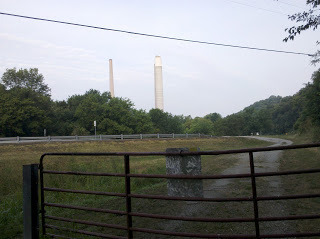
Photo courtesy of Marla Sink Druzgal
So maybe I’m just one of those weird people who find beauty wherever they go, even in large, industrial structures. But I think it’s more than that; I think there’s an argument to be made for the beauty of the stacks.
From a distance, they signal that you’re close to home, while up close, they seem to watch over us all. Because they’re tucked down in the river valley, they’re visible from almost every conceivable spot around Madison; they peek out of the river valley like a small child playing hide and seek. I can see the stacks when I’m on the hilltop in my community garden plot. They loom above the street views downtown if you’re looking west. When you drive up into Clifty Falls State Park, you can eat in the restaurant and stare out at the stacks face-to-face, so to speak. Standing on the hill or from the observation tower, you feel as if you could lean over and whisper your secrets to the stacks. When I’m driving home from the college, they loom up over the hill. Even out at the Wal-Mart on Clifty Drive, the stacks are there, calmly waiting in the distance. As part of our landscape, they are constant reminders of exactly where you are; they are as close as we come to mountains, and like mountains, they sometimes seem to be watching over us.
They are everywhere, but they never look quite the same. Seen from the right angle, all three of them line up and disappear into one, big stack. Sometimes they are lined up very symmetrically, with the two smaller stacks standing on either side of the large one in the middle. But the rest of the time they appear in a wide assortment of sequences and arrangements, and it is as if you are never seeing the same thing twice.
And then there’s the light. The concrete surface of the towers is like a blank canvas upon which all the wonders of the valley are projected. Sometimes, the shadow of one of the stacks falls against one of its sisters, and you get a long, narrow band of dark running up its length, as if there’s dark stack hidden inside suddenly being revealed. On some days, the shadows of clouds play across the stacks. You can often tell from which direction rain is falling by looking at the towers, as one side will be stained dark by the rain and one side untouched.
Then there are the lessons the stacks have to teach us about the quality of sunlight. On some days, they are rosy orange like a maraschino cherry dropped in orange juice. Then before a storm it’s a pea soup green against the smooth concrete. In the height of summer, the stacks seem to glow blinding white-hot. On some mornings, they’re a cheery yellow fit for the walls of a baby’s nursery. And then the next day, they go so dark and gray they almost disappear into the surrounding sky.
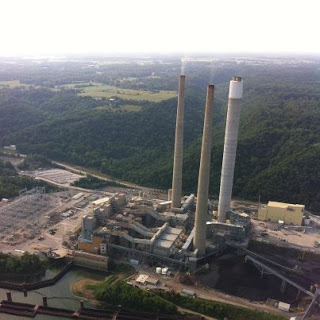
Photo courtesy of Kayla Mosier
At night, the stacks become almost invisible save for the blinking lights on top. But then all the buildings around them are lit up like a small city thriving just outside of downtown. Driving down the hill at night or approaching from the river, the lights of the power plant broadcast something formidable and important happening here. At night, the power plant reminds me of Geogia O’Keefe’s paintings of cityscapes at night–a bright and relentless energy glowing in the dark.
The power plant gives us other, much less pleasant views. In winter with the trees bare, the large retaining ponds behind the plant are revealed, spaces where the earth has been scraped clean. There is something unsettling about the way the power plant seems to creep ever outwards, eating up the land around it in its need for space to dispose of its byproducts. The beauty of the stacks is balanced by these other, more disturbing, views.
Perhaps its best to say that the stacks are both beautiful and terrible. It’s hard, driving by every day, not to think of them as what might be left behind when we are all gone. Maybe they are our pyramids, and future generations will puzzle over what they reveal about us. The stacks will certainly speak in part about a legacy of destruction and shortsightedness. They will speak to the importance of power in our lives, in all the varied meanings of that word. But I hope that they will know that these strange, tall towers growing along our river banks were also sometimes beautiful. And that sometimes, that mattered to us, too.
For more pictures of the stacks, check out my Facebook page, You Think Too Much, here.






Published on December 03, 2012 05:47
December 1, 2012
Me and my iPhone: the metaphysics of gadgets
It wasn’t until half an hour later, as my husband and I were drinking chianti at the Macaroni Grill, that I could identify the source of my lingering anxiety–they had taken my iPhone away. It’s true, they had given me a new one in return. And because everything important about my iPhone is stored in other locations–my laptop, the mysteriously located iCloud–it would soon enough be just like my old iPhone.
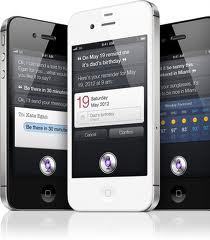
But physically, it was not my old iPhone. Not the phone I had carried around in my purse or pocket for the last seven months. Not the phone I had dropped repeatedly and prayed it would still work when I picked it up. Not the phone that, yes, I have to confess, has gradually come to sit somewhere close to me almost wherever I go throughout my day, like a small, cold, yet, faithful pet.
If my iPhone is nothing more than the data inside that can be easily transferred into a completely different physical shell, what does that say about the world?
This is the question that occurred to me somewhere around my second glass of chianti, because I am a person prone to spend entirely too much time thinking about things like the metaphysical implications of the iPhone.
My husband and I made the smartphone leap just back in April, at which point I wrote a very thoughtful post about how we would be judicious in our use of technology. But iPhones are kind of like a puppy, in that they keep looking up at you with those big, cute, puppy dog eyes, begging you to play with them. And let’s face it, they’re infinitely more useful than a puppy. They can fetch you the paper, of course, but they can also tell you when and where you need to be, help you win arguments with your husband about the nature of genetic inheritance, tune your guitar, store all the little ideas you have for stories or blog posts during the day, and allow you to tell everyone where you are and exactly what you’re doing at any given moment of the day. Whether that last use is a good thing is a whole other question.
Sometimes iPhones do pee on the carpet, technologically speaking. My iPhone acted up within just a couple of weeks of getting it. And then most recently, the new iOS update made it impossible for me to turn my wi-fi on. Which did not prevent me from using the phone, but made it impossible to backup to the magic iCloud, which I have come to understand, is a very bad thing.
I know that not being able to back up to the iCloud is a very bad thing because in an attempt to “fix” my iPhone, I did a restore while hooked up to iTunes, and all the indispensable apps I had downloaded disappeared. This meant at least one idea for a song I had recorded was gone, as well as all the guitar chords for countless songs I had favorited. There was much bitterness, until more tech-savvy members of my family explained to me that it was all still there, in the cloud.
Where is the iCloud? What is the iCloud? I have no idea, and I don’t much care. Sure enough, it brought me back my song fragment and my chord charts. It even remembered in my NFL app that the Bengals were my favorite team. That I don’t understand the iCloud nor care to, and yet am so very dependent upon it, is, I believe, the first step that leads directly to the rise of the Cylons or whatever particular sci-fi scenario you prefer where the machines rule the world. Remember when it all goes down that it started with the iCloud.
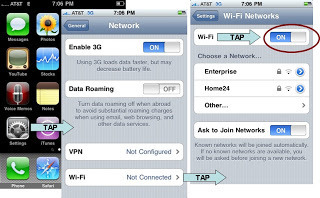
Yes, this is exactly the button that would not turn on
The essence of my iPhone, then, is not in the slim, rectangular device I hold in my hands. Its essence lives somewhere else, and is almost instantaneously transportable into a new physical form. Ruel, my incredibly helpful and chipper Apple specialist at the Apple store, was so calm in assuring me that everything that my iPhone had been before, it would be again. In fact, I would go so far as to say that Ruel was probably a bit puzzled at my need for reassurance that there would really be no difference between my old iPhone and my new iPhone. I didn’t truly believe it until I got it home, hooked it up to iTunes and began re-downloading all my old apps.
And now, sitting happily in the same case, my new iPhone is my old iPhone. Only with functioning wi-fi (for now).
Could we someday create a pet iCloud, where the essential data that makes my cat, well, my cat, could be uploaded and saved. When my cat’s current body goes wonky–say, peeing in inappropriate locations–I could upload all her cat-ness into the petCloud, and then download it into a new body. But would she be the same cat without the sagging gut that swings back and forth beneath her everywhere she goes?
I’m happy to have a fully functioning iPhone again (for now). Sitting in the restaurant with the still empty shell of my phone that had not yet been restored, everywhere around me I saw people communing with their devices. They were often doing more communing with their devices than they were with each other, something which in the past, I would have been quick to condemn. But last night, I just felt left out and sad, missing my iPhone.
And now it’s back, but not really. I cannot quite convince myself it is the same thing. Perhaps it is my obsession with places, but I am not so ready to give up on the importance of the physical. I am not so ready to believe that even a gadget like my iPhone is ultimately reducible to a data stream.
The Maori of New Zealand have a concept called Hau–the spirit of goods–an idea that appears in various forms among people all over the world. The Hau is the idea that there can be “a kind of palpable, yet intangible presence in things.” If you want to think of it this way, it’s as if a little bit of the soul of the person who owns the thing becomes mixed in with the thing: “Souls are mixed with things; things are mixed with Souls.” This is certainly something I believe about physical places. Why would it not be true for a physical object which I kept so close to me for so many months?
Almost everything about our modern lives discourages us from placing any kind of special meaning into objects. Many of our things are disposable and replaceable. Use it today, throw it away tomorrow and get a new one. And yet, there are still some physical objects we cling to. My mother’s wedding ring. A colander that came from my grandmother. A stuffed animal rescued from childhood.
It may very well seem crazy, but I can’t help but wonder where my old iPhone is now. And if it is, somehow, missing me.






Published on December 01, 2012 08:08
November 29, 2012
The end of the term
As I posted on Facebook earlier this week, “Dear god, why isn’t this semester over yet?”
These last two weeks are the hardest time of the year, comparable only to the last two weeks of the whole academic year in the spring. But the two weeks in May are made a bit sweeter by the warm weather, sunshine and growing things. In December, there’s only the anticipation of a brief respite before it’s back to the grind.
What’s worse is that this year Thanksgiving came as early as it possibly could, which means there are two weeks of classes after Thanksgiving break instead of one. For those of you not on academic time, perhaps two weeks seems like no big deal. But in the world of teaching, two weeks after Thanksgiving break may as well be forty years spent in a prison camp. With a urinary tract infection, if prison camp isn’t vividly painful enough for you.

The problem is that two weeks is close to the end, but not quite close enough to allow you to believe it’s really going to be over soon. As a professor, you feel this drag yourself, though the students seem incredulous sometimes that all in all you’d rather be at home in your pajamas, too. And of course the students feel it, which means that the chances of extracting any meaningful work from them becomes mountain-moving in its sheer capacity for complete frustration and exhaustion.
Your students do not want to show up to class. And then they don’t particularly want to show up on time. They don’t want to pay attention. They don’t want to do the readings. They don’t want to talk about the readings. They don’t want to write papers or take exams or generally open their eyes in the morning. And you are RIGHT THERE WITH THEM, but you have to pretend you're not. Conveniently, it’s during this exact moment that we ask our students to fill out course evaluations, the forms upon which many of our livelihoods depend.
Here’s the part where normally I would offer some mildly clever solution, or at the very least, some solution which I believe is mildly clever. But there is no solution to the drag that is the end of the term. There is only the end. May we all find a frothy beverage waiting for us when we get there.






Published on November 29, 2012 08:39
November 23, 2012
Using the whole bird: a vegetarian's Thanksgiving
It’s the day after Thanksgiving, my second year now of feasting on a scrumptious local turkey raised by my friends down the road at Cave Springs Farm. The weight of turkeys that live free and uncontrolled lives doing turkeyish things like moving around, gobbling and eating things that are not re-constituted bits of other animals are hard to predict. The first year we got a local turkey, the smallest bird weighed in at 20 pounds, which was a lot for just my husband and I to consume. This year our bird was a perfectly manageable 12 pounds, and having gained some serious experience this year with what you might euphemistically call “bird processing,” I was firmly committed to getting every penny’s worth out of our bird.
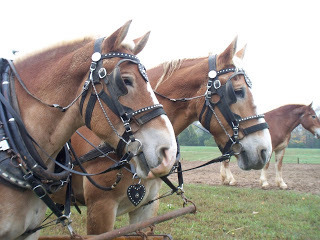
The beautiful draft horses from Cave Springs Farm
In the summer, I helped some friends who raise chickens kill and pluck a chicken for our own table. I started an essay to share that experience with everyone, but it didn’t happen. Which is not to say an essay won’t be coming someday, but for now, let me just say that when you have witnessed the death of something you are going to eat, it changes things. This Thanksgiving, it made it more important than usual to use as much of our turkey as possible.
Our turkey was processed by an Amish butcher, so it came with the innards packed nicely inside along with the neck. These we promptly threw in the freezer for later use. I recently read Kristin Kimball’s memoir of love and farming, The Dirty Life , and there’s a strangely erotic scene where her not-yet-husband farmer cooks her a deer liver. I don’t know if it’ll be erotic or anything, but I’m interested in doing some research on what to do with turkey liver. The neck we’ll use to make more broth.
In the latest issue of Bon Appetit magazine there's a recipe for turkey and mushroom risotto which calls for day after turkey broth, made by boiling the turkey carcass with various vegetables. So today, we cut all the good meat off the turkey, and then I stripped the carcass bare.
Did I mention that before my most recent chicken murdering episode I was a vegetarian for almost fifteen years? I still consider myself largely a vegetarian who only eats meat that has passed through familiar hands. As a sociologist, I understand that disgust and appetite are socially constructed; the thought of eating a worm grosses us out, but it’s delicious somewhere on the planet. As a long-time vegetarian, I know that you can change what you find disgusting. Hell, you don’t have to be a vegetarian to know that. Just think of whatever food you ate right before the last time you puked your guts out. My step-daughter won’t eat Skyline chili to this day.
Watching someone cut up an animal carcass has been disgusting to me for years, maybe even before I stopped eating meat. But, at least for me, being intimate with animal death changes that. Once you’ve held an animal in your hands, carried it to its own slaughter and watched the blood drain out of its body, squeamishness at handling it when it’s dead just seems, well, stupid.
I asked my husband if there was anything erotic about watching his vegetarian wife enthusiastically strip the little bits of meat off a turkey carcass. I guess we don’t quite have the same relationship Kristin Kimball and her husband have, as he thought not so much.

My turkey looked nothing like this by
the time I was done with it
Once the turkey carcass was stripped, I threw it in a stock pot with some onion, carrots and thyme sprigs from out of our back garden. Then for about three and a half hours, it simmered down into broth, filling the house with a smell that was even more delicious than the smell of the turkey in the oven yesterday.
Is it me, or is there something deeply satisfying about the making of broth? The only cooking experience that compares for me in terms of sheer joy is cooking greens, I think because both activities feel like the play cooking I did as a child, in the back yard with little toy pots of grass and sticks. Here are the largely inedible parts of an animal, and we are squeezing every last bit of taste and nutrition out of them–slowly and deliciously. We say thank you, turkey, by using every little bit.
So, any ideas out there for turkey liver?






Published on November 23, 2012 15:46
November 21, 2012
Twinkies, Black Friday and contemplating capitalism
Several times already this holiday season, my stepdaughter has asked whether her father or I will take her shopping on Black Friday. Sadly for her, the answer is a unanimous, "No." It doesn’t seem that there’s anything specific she’s looking to purchase at a Black Friday sale. She just likes the idea of sales, and apparently, there’s something exciting in her 11 year old mind about getting up at two o’clock in the morning to line up outside a store in search of bargains.
Being the daughter of several professors and at least one liberal, feminist, Buddhist, sociologist is a lot to handle when you’re on the cusp of adolescence. So I spared her the lecture that was forming in my head about the evils of capitalism and consumerism, a speech that would have culminated with the glories of community and buying local, and elected to save it for my blog instead. You’re welcome.
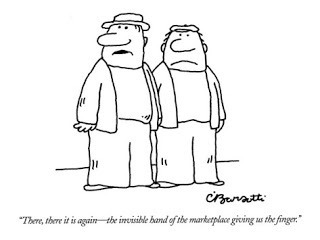
Cartoon by Charles Barsotti
My stepdaughter’s interest in Black Friday is really just the latest manifestation of a new, and sometimes intense, concern with the acquisition of money and the buying of things. She does chores around our house for which she receives a small allowance, but she is clearly–in her mind–coming up against the spending limits of that small allowance. Her father and I are coming up against the limits of how many things we can find to realistically pay her to do around the house.
On the one hand, the concept that if you want things, you will have to work somewhat to get them seems like a good lesson to learn. Of course, we buy her things, too, but it seems to me beneficial for a child to learn that not everything she wants will be magically provided. The big lesson seems to be that earning money provides a kind of freedom that relying on others to get you things does not. This lesson sounds much more disturbing written out on the page than it did in my head. I’m teaching my child that money = freedom? And yet, explaining to her that real freedom comes from non-attachment and learning not to want things seems like a lot to grasp at that age.
Next door, the regular wake up we would get at about 4:00 every morning when our neighbor heads out to deliver the bread is gone. Amidst all the joking about Twinkies and Ho-Hos and Ding-Dongs, our neighbor finds himself suddenly without a job right before the holidays due to the demise of Hostess. An older man who has worked hard all his life unexpectedly finds himself, through no fault of his own, able to sleep in. And in a very real way, he has less freedom this week than he did before because he no longer has a job.
This, many economists would tell me, is just capitalism doing what it does. Though Hostess executives blame the union for shutting down the company, this is their second trip through bankruptcy, indicating there were more problems than just labor costs. Among the problems are changing consumer tastes. A lot of people claimed to be upset about losing their Twinkies, even though not many of us have actually eaten a Twinkie for a long time.
So this is the invisible hand of the market at work. As consumer tastes change, some companies go out of business. Some things stop being made. Some people lose their jobs. It all makes sense in the abstract. And in fact, as the Twinkie can be argued in many ways to be the epitome of what’s wrong with the way we eat, perhaps we should be cheering the downfall of Hostess. It all sounds perfectly acceptable in the abstract. Except that my neighbor lost his job.

I would like to teach my stepdaughter that there’s a value to working towards the earning of something, but that “something” doesn’t necessarily mean a pair of shoes. I would also like her to understand someday that there’s often a kind of emptiness in the wanting of things. But if I teach her to buy less, I’m hurting the economy. Her budding acquisitiveness potentially keeps someone like my neighbor employed. Parenting truly brings the complexity of the world into a harsh new light.
“So what’s the solution?” my students would ask at this point. Or probably they wouldn’t ask, because compared to them, I’m a virtual Pollyanna, and so they actually would have already resolved themselves to the inevitability of the way things are. But I believe there is never anything inevitable about the way things are.
Systems that create casualties as a part of their natural functioning seem just fine to most of us until we come face to face with one of those casualties in a way that makes it suddenly unacceptable. Who cares that roads and cars kill millions of animals until it’s your pet? Who cares that the operation of the free market economy inevitably puts people out of work until its your neighbor? Or you?
Philosopher John Rawls suggests that if none of knew for sure that our pet would not be killed or that we would not be the one left without a job in the capitalist game of muscial chairs, the world might look very different. Our ideas about what is “just,” Rawls argues, are deeply tied to our own expectations about whether or not we will ever be affected by the consequences of injustice. If you don’t believe you’re ever going to be unable to pay for health insurance, what do you care whether it should provided to everyone universally?
Rawls’ theory might help explain why the prevailing temperament in societies tends to get a bit more anti-capitalist in the midst of economic recessions and depressions. Suddenly, large swaths of the population find themselves in those very positions in which they never thought they’d find themselves, and from that vantage point, everything looks a little less right.
I don’t know exactly what a better system would look like in regards to our economy, though I have my suspicions that it would involve less consumerism and a little more humanizing of economic transactions. But I believe that we can do better than tolerate a system that causes such anguish, destruction and pain as a part of its natural functioning. I have faith that the amazing ingenuity of humanity certainly makes it possible. The important question is whether or not we find it desirable.






Published on November 21, 2012 06:12
November 18, 2012
Could Sam Gordon play in the NFL someday?
On yet another Sunday of less than mediocre football in the NFL, the best story by far was Samantha Gordon’s appearance on NFL Network’s pre-game show, Game Day Morning. The 9 year old overnight youube sensation tackled Marshall Faulk and juked Warren Sapp. The guys were clearly delighted at the talent and charisma of this young internet sensation, but the question no one asked was, could the guys someday be discussing Samantha Gordon as more than just a gender novelty? In other words, could Samantha Gordon play in the NFL someday?

Samantha Gordon is certainly not the first girl to play Pop Warner football. If she continued to play, she would not be the first girl to play at the high school level. Many women have kicked and punted for high school and college teams. At least one woman, the younger sister of Jets’ center Nick Mangold, has played offensive linemen at the high school level. Placekick holder Patricia Palinkas was the first woman to play professional football in a league made up predominantly of men; she held the football for her husband, Steven Palinkas, for the minor league football team, the Orlando Panthers.
What is different about Samantha Gordon is that, at least at the age of nine, she’s really good, and not as a kicker, punter or placekick holder. Gordon plays running back, some quarterback, and some defense. She takes hits and gives hits, and consistently outruns all the boys on the team, whose best chance for stopping her appears to be to pull her hair.
Research by gender scholars demonstrates that it is much easier for girls to enter the domain of boys than it is for boys to act girlish. Right now, Samantha Gordon is reaping the rewards that society often gives to girls who demonstrate mastery of “masculine” activities. Tomboyish tendencies in girls usually come to an end around puberty, when the pressure on young girls and boys to fit in rather than stand out is turned on full force. Who knows whether Gordon will choose to continue playing football into middle school, high school or college? Who knows if the talent she seems to demonstrate at this early age will continue? But what if it did? Could Samantha Gordon play in the NFL?
Segregated sports
One of the questions I often ask students in my sociology of gender course is: Why are sports segregated on the basis of gender in the first place? What would the sports world look like if we did not segregate our sports by gender? Would there be men playing in the Lingerie Football League?
Suppose, I ask them, all professional sports followed the model of Major League Baseball or wrestling. Instead of the NBA and the WNBA, there would instead be various tiers based on ability or weight class. Teams would be organized not by gender, but by ability. Would any women play in the very top tier leagues? Would Samantha Gordon be able to play in the NFL, or would she be confined to the C or D league professional football teams, along with a small scattering of talented women?
Most students–both women and men–argue quite vehemently that no women would be able to compete at the top level. They are physically incapable of competing with the best men; they simply do not have the athletic ability. This argument assumes that everyone who plays at the elite level of professional sports is there solely because of superior athletic ability. Certainly, it would be hard to play in the NFL, MLB, NHL or NBA with no athletic ability at all; but surely work ethic, sports intelligence, motivation and (dare I suggest?) who you know might also have something to do with it?

But let’s look at the natural athletic ability argument a bit closer before dismissing it completely. Perhaps women don’t have quite the same level of athletic ability that men do...for now. There’s plenty of evidence that this has less to do with anything “natural” than it has to do with society and culture. Many presumably “natural” differences between women and men have changed over time. Average height differences between women and men are closing, most demographers believe as a result of families worldwide providing equal amounts of food to their daughters and sons, which in turn affects their adult height. The difference between men’s world records in distance running events and women’s have been lessening. These are just two examples of “natural” differences that appear to have a cultural basis.
Athletic ability is certainly partly about genetic inheritance, but it is also very much a product of a culture which encourages different groups of people to engage in different kinds of activities. Why does Kenya produce so many great distance runners? Is it genetics, or the fact that in the rural areas of Kenya, children run long distances on a daily basis from a very young age? Is this an advantage over American athletes who run not at all as children and who often are unable to start running competitively until high school? If boys receive more opportunities to play football, baseball and basketball at a younger age than girls do, could this partially explain their superior athletic ability? If more girls like Samantha Gordon start playing football at young ages, would they be able to narrow the gap in athletic ability?
Which brings us to the real heart of the matter. Who knows if Samantha Gordon could play in the NFL someday? Maybe she could. But how much sense does it make for a 9 year old girl to dedicate her life to a future that is only a vague possibility? The chances for any 9 year old boy of someday being able to play in the NFL are infinitesimal, but still more possible than the chances for a 9 year old girl. Thanks to Title IX, girls have more motivation to play sports than they have in the past; there are, in theory, equal numbers of college scholarships to be earned for female and male athletes. But what happens after college?
If you’re a girl who plays soccer, there are no professional women’s soccer leagues left in the United States. You can play in the WNBA and make a maximum of $87,000 per year, compared to the lowest paid NBA player, who still earns $700,000. If you fell in love with Little League as a girl, you’ve already been shuttled into softball, where you can play in the National Pro Fastpitch league for a whopping $6,000. And if you’re Samantha Gordon, the most popular professional woman football players compete in their underwear.
Sociologists understand that motivation is connected to the ability to imagine yourself in a future role. If it is fairly easy to imagine someone like you scoring the winning touchdown in the Super Bowl, then it’s going to increase your dedication to achieving that dream. But if it seems like something that is impossible not just for you to imagine, but for anyone to imagine, how long can that kind of dream be sustained?
Who knows what Samantha Gordon will want as she grows up? Perhaps playing football with the boys will get old or boring. Perhaps she doesn’t really have the right stuff. But watching her dash down the field on youtube, perhaps we can begin to dream a different kind of sports dream. Watching her tackle, perhaps we can imagine what it would be like if more women played alongside men. Perhaps we can make the answer to the question–could Samantha Gordon play in the NFL–a little more likely to be, “Yes!”






Published on November 18, 2012 15:11
November 17, 2012
In the end, a writer writes
I’m back after a brief take-over by Mr. Attack Resistance, who explained everything you need to know about Twitter in three parts. Or maybe not quite everything...
This three part Twitter tutorial was inspired by my own confused entrance into world of Twitter and Mr. Attack Resistance’s attempts to counsel me through this difficult transition. I will confess to you now that during my first few days of full Twitter engagement, I would wake up sometimes in the middle of the night with the vague sense that I was supposed to be tweeting something or that I had committed some irretrievable Twitter faux paus. That undoubtedly says more about me than it does about Twitter.
If you are a writer who would like to be published, there are many books, websites and blogs that will sing the praises of social media and platforms, making convincing arguments for how these are indispensable to your future success. And on Twitter, you can follow all kinds of literary type people...agents, aspiring writers and published authors (Sherman Alexie, not surprisingly, is pretty hilarious).
It was through Twitter that I discovered this online essay, Would Jane Austen Write a Blog? (and other things writers probably shouldn’t do), in which Cath Murphy explains why Jane Austen would probably not have blogged, Oscar Wilde would not have tweeted, and Charles Dickens would not have participated in NaNoWriMo. Mostly I agree with what Murphy has to say, and it confirmed a growing suspicion I’ve had since joining Twitter–that in the end the most important thing a writer does is write.

What Would Jane Austen Do?
I can totally see the seductive power of Twitter and blogs and other social media for aspiring writers. Especially with Twitter, there’s the sense of being so very close to the center of the writing and publishing world. I can see intimate details of this literary agent’s life on an almost minute by minute basis; surely she is my best friend who is just waiting to read and fall in love with my novel. I’m only following 39 people, and I already feel completely overloaded with information about how to get published, how to write a query letter, how to build a platform and a little bit of how to write. I could easily spend entire days following these various trails down respective rabbit holes. But then when would I write?
Obviously, unlike Jane Austen, I do have a blog. Writing my blog was a central part of the path that led me back to writing at all, a circuitous route that also involved a sociology of gender textbook. I continue to write for my blog because I see it as complementary to the other writing I do. Put simply, being able to get a little bit of instant gratification and feedback for my writing by posting on my blog allows me the freedom to do the harder kind of writing that provides absolutely no instant gratification and feedback. Also, there’s the fact that wring my blog just makes me happy.
Twitter is a very powerful social media tool and there are certainly folks who have landed book deals in part because of social media like Twitter, though at some point they still had to write something longer than 140 characters. But in the end, a writer has to write. So I’m not going anywhere, and if you want to follow me on Twitter, you’re more than welcome. But as someone who has a day job, faced with the choice between spending countless hours building a social media empire and writing, I’ll be choosing writing.






Published on November 17, 2012 08:41
November 16, 2012
Twitter 101, Episode 3: You Don't Know Hash!
It's Friday, and I'll be taking my blog back soon. Today is the last guest post by Mr. Attack Resistance, in which he finally gets to the point and tells you how to use Twitter, and more importantly, that you should follow me. And I guess him, too. You should also check out his blog, conveniently called Attack Resistance, and leave harassing comments until he posts more often, thus demonstrating that not everything worthwhile can be said in 140 characters or less.
So begins my third, and final, installment on why you should
love Twitter. I’d like to thank my gracious
host for allowing me to ramble on for the last three days and, of course,
you Dear Readers
for coming along with me on this tangent filled journey. If you are, somehow,
just now joining us you can find part one here,
and part two, here
(anyone else get weirded out by referring to an HTML link as a physical
place?).

By now, you should understand how humanity evolved from
loving shadow puppets to loving truncated communication forms and you should
also be aware of that you can use Twitter to survive an earthquake [AUTHOR’S
NOTE: Don’t use Twitter for any form of emergency response]. What you don’t
know, yet, is how to actually use Twitter. That’s what we’re going to address
today. Let’s get started.
Like any other social media website, you’ll need to setup a
profile by selecting a user name, password, and providing a few details. Your
Twitter handle can be anything you want it to be, provided it isn’t already being
used and doesn’t violate the Terms of Service you said you read but didn’t.
Your user name will be proceeded by the @ symbol, so if your user name is, say,
AttackResist, it would appear thusly: @AttackResist
When someone types your @ in a Tweet they have ‘mentioned’ you (just like
tagging someone in a Facebook post). A common way for people to tag another
user within a tweet is to add a ‘cc:’ to the tweet. For instance:
I read recently that sociologists
drink more beer than any other profession. cc: @think_too_much
It’s important to note that this is publicly viewable.
Anything you say in this manner will be seen by anyone who is following you or
anyone who is weird
enough to search Twitter for ‘sociologists drink more beer’.
Now, if you’re
having a conversation with a common theme or if you’d just like to mark your
tweet in a unique way you would use a hashtag. Hashtags are in vogue at the
moment and were developed by the users of Twitter independent of any of the
programmers.A real world example of the proper use of the hashtag follows:
I read recently that sociologists
drink more beer than any other profession. #ThingsRobynAlreadyKnows cc:
@think_too_much
Inside Twitter, hashtags can be clicked and this will bring
up a list of all tweets containing the same tag. This can be exceptionally
useful if you want to keep track of a particular hashtag. Twitter will display
to you the most popular hashtags by country, region, or locality at your
discretion allowing you easy access to the conversations going on around you.
Hashtags won’t recognize any punctuation marks so give up any hope of being
grammatically correct when using one. While not required, I suggest
capitalizing each new word in a tag to allow for easier reading.
At some point
you’ve probably seen a hashtag on Facebook and asked yourself, “What the hell
does that mean?” Well, now you know. And you also know that the person using
the hashtag is infinitely cooler than you. Get your stuff together. You disgust
me.
Again, everything you tweet is viewable and searchable by
the public at large. EXCEPT! Except for Direct Messages. Direct messages are
tweets between two (and only two) users. All the same rules apply here. 140
characters, hashtags, etc. the only difference is that visibility is limited to
you and your recipient. Use Direct Messages when you want to say something you
don’t want everyone else to see. Let me say that one more time: Use Direct
Messages when you want to say something you don’t want everyone else to see.
Another key feature of Twitter is the retweet. Retweets are
used to quickly and easily share a tweet you’ve found interesting. They can
exist in a few different formats:
. RT – You will encounter tweets from time to time
that start with the letters RT. This is a more manual way of retweeting something.
You copy the text of the tweet, start a new tweet by writing RT – and then
pasting.
.
MT – This stands for modified tweet. These occur
when someone takes a tweet, alters it in an appreciable way, and rebroadcasts
it.
.
H/T – This stands for Hat Tip. Usually used when
you take just part of a tweet (a link or a picture, typically) and build your
own message around it.
.
Just hit the damn Retweet button.
Use retweets judiciously. Like it or not, they can imply
endorsement or support.
Okay, almost done. We’ve covered character limits (140),
mentions (@attackresist), Direct Messages (quit snooping, jerk!) hashtags (#PayAttention),
Retweets (Retweets). Now let’s talk about one more thing: Link shortening.
Twitter will most often do this for you, simply by pasting a
link, but there are other ways. The most popular of which is bit.ly. I use this with some frequency, and you
should too. Because I said so. Using link shorteners allows excessively long
links to fit in an otherwise lengthy tweet. For instance, the following tweet
exceeds the 140 character limit:
@AttackResist doesn’t update often
but his blog is awesome and you should read it whenever he does. http://www.attackresistance.blogspot.com
However, with a link shortener that same tweet fits the
limit:
@AttackResist doesn’t update very
often, but his blog is awesome and you should definitely read it whenever he
does. http://bit.ly/eZ3sjJ
There you have it, kids: The bare minimum needed to get
started using Twitter. I strongly suggest that you immediately follow @think_too_much. You’re already a
fan, else why would you be reading this? Thanks mom, but you
don’t count. You should also follow me,
because I am amazing. Once you’re up and running, give me a shout. I’ll hold
your hand while you get better acquainted with the most useful communication
tool since the shadow puppet.
This is Mr. Attack Resistance, signing off.






Published on November 16, 2012 06:43
November 15, 2012
Twitter 101, Episode 2: Faster than earthquakes
Today, welcome back Mr. Attack Resistance for his second guest blog about Twitter--why Twitter is faster than earthquakes.
Here’s the second installment of my three part series on the
ins and outs of Twitter.
If you missed the first part, you can find it here
or you can read this brief recap:
First there was fire. Then shadow
puppets. Everyone hates shadow puppets now, unless you’re this guy. 45,000 years go
by until it occurs to someone to write down their thoughts. Most probably a
husband trying to document what he actually said. Another 4,000 years brings
printing presses, so we can blame Gutenberg for US Weekly. Then telegraph, then telephone, radio, TV, fax, ARPANET,
Al Gore’s Interwebz, e-mail, Sixdegrees.com, MySpace, Facebook, Twitter.
So let’s talk about why you should use Twitter. The most
prevalent piece of feedback I get about Twitter is from people who claim they
don’t “get it”. One person even said, publicly, “What is the point of Twitter?
Only 140 characters? I don’t get it.” It’s worth noting that this statement is
66 characters long and was made as a Facebook status. The point, of course, is
that most people already get it, they just don’t understand how to function in
a social media realm that isn’t constantly bombarding them with ads or
invitations to milk a pink cow that exists strictly as a series of 1s and 0s.
Let’s strip Facebook down to its core and see what is left after the fluff is
removed:
Status updates – Small snippets of text used to
start conversations or make declarations. Typically just a couple of sentences.
Photos – People take a picture, then upload it
to Facebook. Little known fact: This was, originally, one of the main reasons
for having a Facebook page.
Links – You read a funny blog
post, and then share it with your friends.
Private Messages – You want to talk to a friend
about something that is potentially inflammatory, but don’t want the drama that
will come from saying it publicly.
Event Invitations – You’re celebrating the end
of political ads by gathering all your friends together and drinking copious
amounts of gin. One message
allows you to invite everyone and see who’s come.

These real cows want you to Tweet
Ready for a bombshell? Twitter can do all of these things.
Best of all? You’re not going to get buried in invitations to join an electronic
mob or to unlock new jewels in some weird solitaire game, and there will be
far, far fewer instances of that one person you said hello to one time in high
school friending you and subjecting you to all of their personal drama. See,
with Twitter, you’re not subjected to requests to be on someone’s list of
followers like in Facebook. Someone follows you and they see what you tweet. If
you like what they have to say you follow them back. If their BS gets too
annoying you just unfollow them. It doesn’t send them a message or anything,
you just stop seeing what they tweet. The end.
More than that, though, Twitter is much more searchable than
other social media. This is accomplished, in part, by using the vaunted
hashtag. I’ll talk more about hashtags tomorrow,
when we get into the how of Twitter,
but right now you just need to understand that it’s a searchable tag that is
used to group like comments together. The best part, to me, is that when trends
start happening you can see this instantly and globally.
For instance, during
the rather rare Eastern
quake in 2011 people were reading tweets about the earthquake moving up the
coast before the shaking started. They were mainly “WTF? Was that an
#Earthquake?” tweets, but I can foresee an early warning system that could
automatically alert people in the affected area (outside of the epicenter, of
course). Maybe then Italy could pull their head out of their asses and release
those scientists they jailed for not predicting an earthquake.
Because of this ability, and because I am addicted to my timeline, I typically
know about regional, national, or global events long before typical media
outlets have even begun to think about what to say.
Here’s a great for instance:
On November 10th, 2012 at around 11PM EST a house exploded in
Indianapolis, killing two, injuring others, and damaging lots of surrounding
property. The first tweet I saw about it was at 11:11 PM EST. In just ~10
minutes after a catastrophic event occurred roughly 100 miles away from me I
heard about it from a friend in the area. They didn’t call, they didn’t text,
they told everyone in their followers list at the same time. Within a few hours
there was a hashtag floating around that allowed for easier tracking. #IndyBoom
started trending and suddenly the nation is in on the whole affair. There was
the inevitable dust up as some people got a little offended about the seeming
crassness of #IndyBoom, but these are people that probably don’t understand
that succinctness is key when communicating in this venue. If you were watching
the evening news in Indianapolis you would not have heard about it. Twitter is
faster than your local news station.
So! Let’s review. Twitter is great because:
Does everything Facebook does.
No farms, no mobs, no annoying invitations.
No high school BS drama about friending or unfriending someone.
Faster than your local news stations. Also, earthquakes.
Searchable. You can find out what people are saying about your favorite subject at any given time. Anywhere in the world.
Easier to share other people’s content.
I’m there.
Tune in tomorrow for a lesson on how to get started with
Twitter and some suggestions on who to follow, who to avoid, and what mistakes
you’re probably going to make when you get started.







Here’s the second installment of my three part series on the
ins and outs of Twitter.
If you missed the first part, you can find it here
or you can read this brief recap:
First there was fire. Then shadow
puppets. Everyone hates shadow puppets now, unless you’re this guy. 45,000 years go
by until it occurs to someone to write down their thoughts. Most probably a
husband trying to document what he actually said. Another 4,000 years brings
printing presses, so we can blame Gutenberg for US Weekly. Then telegraph, then telephone, radio, TV, fax, ARPANET,
Al Gore’s Interwebz, e-mail, Sixdegrees.com, MySpace, Facebook, Twitter.
So let’s talk about why you should use Twitter. The most
prevalent piece of feedback I get about Twitter is from people who claim they
don’t “get it”. One person even said, publicly, “What is the point of Twitter?
Only 140 characters? I don’t get it.” It’s worth noting that this statement is
66 characters long and was made as a Facebook status. The point, of course, is
that most people already get it, they just don’t understand how to function in
a social media realm that isn’t constantly bombarding them with ads or
invitations to milk a pink cow that exists strictly as a series of 1s and 0s.
Let’s strip Facebook down to its core and see what is left after the fluff is
removed:
Status updates – Small snippets of text used to
start conversations or make declarations. Typically just a couple of sentences.
Photos – People take a picture, then upload it
to Facebook. Little known fact: This was, originally, one of the main reasons
for having a Facebook page.
Links – You read a funny blog
post, and then share it with your friends.
Private Messages – You want to talk to a friend
about something that is potentially inflammatory, but don’t want the drama that
will come from saying it publicly.
Event Invitations – You’re celebrating the end
of political ads by gathering all your friends together and drinking copious
amounts of gin. One message
allows you to invite everyone and see who’s come.

These real cows want you to Tweet
Ready for a bombshell? Twitter can do all of these things.
Best of all? You’re not going to get buried in invitations to join an electronic
mob or to unlock new jewels in some weird solitaire game, and there will be
far, far fewer instances of that one person you said hello to one time in high
school friending you and subjecting you to all of their personal drama. See,
with Twitter, you’re not subjected to requests to be on someone’s list of
followers like in Facebook. Someone follows you and they see what you tweet. If
you like what they have to say you follow them back. If their BS gets too
annoying you just unfollow them. It doesn’t send them a message or anything,
you just stop seeing what they tweet. The end.
More than that, though, Twitter is much more searchable than
other social media. This is accomplished, in part, by using the vaunted
hashtag. I’ll talk more about hashtags tomorrow,
when we get into the how of Twitter,
but right now you just need to understand that it’s a searchable tag that is
used to group like comments together. The best part, to me, is that when trends
start happening you can see this instantly and globally.
For instance, during
the rather rare Eastern
quake in 2011 people were reading tweets about the earthquake moving up the
coast before the shaking started. They were mainly “WTF? Was that an
#Earthquake?” tweets, but I can foresee an early warning system that could
automatically alert people in the affected area (outside of the epicenter, of
course). Maybe then Italy could pull their head out of their asses and release
those scientists they jailed for not predicting an earthquake.
Because of this ability, and because I am addicted to my timeline, I typically
know about regional, national, or global events long before typical media
outlets have even begun to think about what to say.
Here’s a great for instance:
On November 10th, 2012 at around 11PM EST a house exploded in
Indianapolis, killing two, injuring others, and damaging lots of surrounding
property. The first tweet I saw about it was at 11:11 PM EST. In just ~10
minutes after a catastrophic event occurred roughly 100 miles away from me I
heard about it from a friend in the area. They didn’t call, they didn’t text,
they told everyone in their followers list at the same time. Within a few hours
there was a hashtag floating around that allowed for easier tracking. #IndyBoom
started trending and suddenly the nation is in on the whole affair. There was
the inevitable dust up as some people got a little offended about the seeming
crassness of #IndyBoom, but these are people that probably don’t understand
that succinctness is key when communicating in this venue. If you were watching
the evening news in Indianapolis you would not have heard about it. Twitter is
faster than your local news station.
So! Let’s review. Twitter is great because:
Does everything Facebook does.
No farms, no mobs, no annoying invitations.
No high school BS drama about friending or unfriending someone.
Faster than your local news stations. Also, earthquakes.
Searchable. You can find out what people are saying about your favorite subject at any given time. Anywhere in the world.
Easier to share other people’s content.
I’m there.
Tune in tomorrow for a lesson on how to get started with
Twitter and some suggestions on who to follow, who to avoid, and what mistakes
you’re probably going to make when you get started.






Published on November 15, 2012 04:15
November 14, 2012
Twitter 101: Episode 1, Timeline of Human Communication
Today is my first ever guest post on You Think Too Much! As promised, my good friend Mr. Attack Resistance has written the first in a three part installment on the wonder and beauty that is Twitter. Stay tuned tomorrow for the next installment on the goodness of Twitter (though I still doubt I will be convinced it is better than fuzzy socks).
Hey gang! Mr. Attack Resistance here, and I’ve been asked by my good friend to talk to you about Twitter. Yes, Twitter. She’s given in, you see. Thrown in the electronic towel, as it were, and has joined the bestest social networking site around. So far she has one follower. Off to a great start! To begin my professing of all things Twitter I have to start with fire. Some of you will ask why that is. I’ll reply by saying, “Mind your own business!” The truth is, kids, you can’t discuss how Twitter has truly impacted the way in which we communicate without first understanding how that has evolved over the millennia. So, without further ado, please enjoy my:
Timeline of Human
Communication
~50,000 Years Ago:
Fire invented. Shadow puppets make a big splash, reducing in popularity every
day since inception.
~35,000 Years Ago:
Spoken word. Knock-Knock jokes somehow invented before the door. No one asks,
“Who’s there?” for another 25,000 years.
~5,000 Years Ago:
Sumerians invent writing. “King Enki was here” first known graffiti, painted in
an ancient alleyway in Eridu.
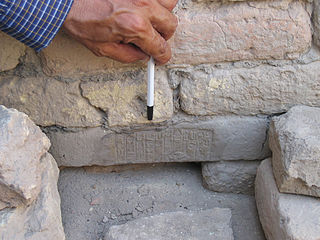
1436 AD: Johannes
Gutenberg begins working on his printing press. He is sued in 1439 for failure
to repay loans. Sadly, the irony of the lawsuit being printed on the Gutenberg
press is lost to most people of the time.
1844: Samuel
Morse successfully sends his famous message by transmitting the words, “What
hath God wrought” from the halls of the Supreme Court to the B&O Outer
Depot in Baltimore. 164 years later, The
Wire is cancelled and no one has a reason to care about Baltimore ever
again.
1876: Alexander
Graham Bell awarded patent for invention of the telephone. Watson doesn’t
forgive him for yelling rudely that one time until 1880.

1881: Oddly,
emoticons invented in this year and published by satirical magazine Puck. No, really.
1897: Nikola
Tesla files the first two patents for radio in the US. Some dick named Marconi
is given all the credit.
1926: John Logie
Baird demonstrates what is widely believed to be the first television
transmission. Hipsters everywhere claim it hasn’t been as good since.
1964: The Xerox
corporation introduces the first commercially available fax machine. Two days
later the first unsolicited fax offering cheap cruise line vacations is
received.
1969: ARPANET
transmits two letters of the first electronic message before it crashes. 26
years later, Bill Gates uses this system stability as his benchmark for Windows
95.
1982: Al Gore
finally gets around to inventing the Internet.
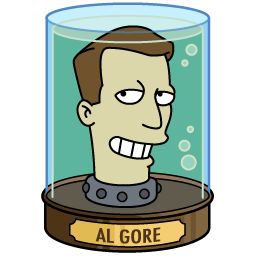
1982: E-mail also
invented this year. Subject of first e-mail is reportedly, “Who the Fuck Is Al
Gore?”
1988: Robert
Tappan Morris releases the Morris Worm to “gauge the size of the Internet”. The
US legal system disagrees with his methods and he is the first person sent to
prison for a cybercrime.
1997:
SixDegrees.com is launched and is widely believed to be the first true social
networking site. They stupidly ignore the allure of Kevin Bacon and fold
shortly afterward.
1998: Google
founded on September 4th. Number of drunken brawls started by trivia
questions plummets by 99.995% within five years.
2003: MySpace
founded. First known awkward self-portrait of teenage girl in her bathroom
posted within 24 hours.

2004: Facebook
launches under the name TheFacebook.com. Facebook goes on to becomes the
world’s number one way for friends to tend fake farms online while complaining
about food shortages in Africa.
2006: Twitter
launches on March 21st when founder Jack Dorsey tweets, “just
setting up my twttr” at 9:50PM PST. 5,000 years of the written word is
compressed to just 140 characters. Politicians still find a way to piss people
off.
Is that all perfectly clear? And for the record, Mr. Attack Resistance, I have a grand total of 8 followers on Twitter now. Tomorrow, why Twitter is good for things besides just seeing how stupid politicians are.






Published on November 14, 2012 05:53



